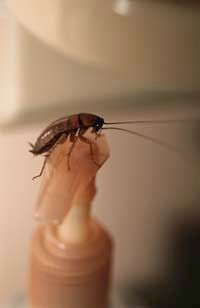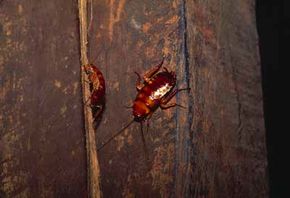Before you start spraying pesticides on every open surface of your house in an attempt to kill the roaches, you need to strategize. Plotting out an attack on a group of insects may sound borderline crazy, but you'll have more success if you plan ahead.
To do that, let's go back to those three things that roaches need: warm areas, food residue, and water. Taking away those elements is like serving them an eviction notice. A single pesticide will not permanently do the job [source: University of California Statewide Integrated Pest Management].
Setting Up Traps
First, you need to figure out where the bugs have set up camp. If you've noticed them in an isolated area, such as the kitchen sink, that's a decent clue they're hidden away in there. For a more precise indicator, put out strips of roach traps that are coated with a sticky glue to stop them in their tracks.
The heavier trafficked strips should be closest to their nest. You can use this method repeatedly throughout your roach-eradicating mission to check your progress and whether they've changed locales. Also check around for droppings, egg sacs, shed skins, and exoskeletons.
Eliminate Their Food Sources
While you're waiting on your trap results, you've got some cleaning to do. Even if you keep things tidy, you probably haven't covered every spot that serves as a feeding trough for roaches. Items in particular that you should get rid of include:
- Piled newspapers
- Cardboard boxes
- Paper bags
- General piles of clutter where roaches can hide
Roaches are especially drawn to paper products because they readily absorb a certain pheromone, or chemical attractor, that roaches emit. This aggregation pheromone is like a GPS system, whereby roaches communicate their locations to others and leave a trail for them to find their ways back and forth.
Remove Food Particles and Water
It's also time to give your house, and especially your kitchen (where you store food), an intense bathing. Get any fresh fruits, vegetables, and bread off the counters and into airtight containers. Check through your groceries and secure open bags and boxes. Clean the eyes on the stove, inside the oven, the microwave, and other appliances. Pay attention to grease because even small spots of it are like foie gras for roaches. Sweep or vacuum behind large appliances and remove any food debris at the bottom of dishwashers.
After all of that, you must maintain a high level of cleanliness to eliminate your pest problem. Never leave dirty dishes in the sink, or abandon food on countertops. Routinely sweep after cooking and take out your trash.
Perhaps more than food, roaches seek out watering holes. For that reason, search around for places that could collect water, such as plants, the drip plate under your refrigerator, or condensation around leaky water pipes. Try to keep those areas dry, especially at night when roaches feed.
Place stoppers over your drains and check your faucets to ensure that screens cover their spouts where roaches could crawl in [source: Ogg et al]. Also, place some traps around your plumbing pipes to make sure cockroaches aren't in the vicinity. Now you're ready to pull out the big guns. Learn how on the next page.

